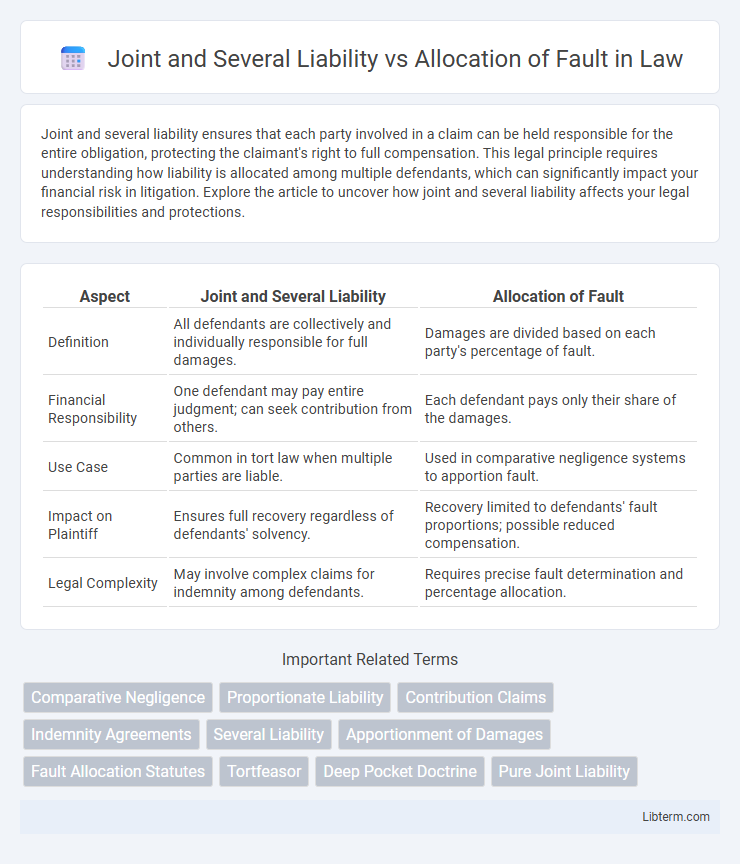Joint and several liability ensures that each party involved in a claim can be held responsible for the entire obligation, protecting the claimant's right to full compensation. This legal principle requires understanding how liability is allocated among multiple defendants, which can significantly impact your financial risk in litigation. Explore the article to uncover how joint and several liability affects your legal responsibilities and protections.
Table of Comparison
| Aspect | Joint and Several Liability | Allocation of Fault |
|---|---|---|
| Definition | All defendants are collectively and individually responsible for full damages. | Damages are divided based on each party's percentage of fault. |
| Financial Responsibility | One defendant may pay entire judgment; can seek contribution from others. | Each defendant pays only their share of the damages. |
| Use Case | Common in tort law when multiple parties are liable. | Used in comparative negligence systems to apportion fault. |
| Impact on Plaintiff | Ensures full recovery regardless of defendants' solvency. | Recovery limited to defendants' fault proportions; possible reduced compensation. |
| Legal Complexity | May involve complex claims for indemnity among defendants. | Requires precise fault determination and percentage allocation. |
Introduction to Joint and Several Liability
Joint and several liability allows each defendant to be individually responsible for the entire amount of damages regardless of their share of fault, ensuring full compensation for the plaintiff. This legal doctrine contrasts with allocation of fault, where financial responsibility is divided proportionally based on each party's contribution to the harm. Understanding joint and several liability is crucial in tort law and personal injury cases, as it impacts settlement negotiations and the enforcement of judgments.
Definition and Principles of Allocation of Fault
Allocation of fault refers to the legal principle where the degree of responsibility for damages is distributed among multiple parties based on their respective contributions to the harm. This principle assigns specific percentages of liability to each defendant, which directly affect the compensation each party may owe. Unlike joint and several liability, allocation of fault limits each defendant's financial responsibility to their proportional share of the fault, promoting fairness in damage recovery.
Legal Foundations: How Liability is Determined
Joint and several liability holds each defendant individually responsible for the entire amount of damages, allowing plaintiffs to recover full compensation from any party regardless of their degree of fault. Allocation of fault, also known as comparative fault, divides damages proportionally among parties based on their percentage of responsibility assigned through legal findings. Courts establish these legal foundations through statutory laws and precedents, ensuring clear guidelines on how liability is determined and enforced in civil litigation.
Comparative Overview: Joint and Several Liability vs. Allocation of Fault
Joint and several liability holds each defendant individually responsible for the entire damage award regardless of their degree of fault, ensuring plaintiffs can recover full compensation from any party. Allocation of fault, often based on comparative negligence principles, assigns damages proportionally according to each defendant's percentage of responsibility for the harm. This distinction critically affects litigation strategy, potential recovery amounts, and risk assessment in multi-defendant tort cases.
Advantages of Joint and Several Liability
Joint and several liability allows a plaintiff to recover the full amount of damages from any one defendant, ensuring complete compensation even if other parties are unable to pay. This legal approach strengthens plaintiffs' protection by shifting the risk of insolvent defendants to financially capable ones. It promotes accountability and encourages defendants to negotiate settlements rather than risk paying disproportionate damages in court.
Benefits of Allocating Fault Proportionally
Allocating fault proportionally ensures that parties are held responsible only for the damages corresponding to their degree of fault, promoting fairness in legal judgments. This method reduces the risk of disproportionate financial burdens on defendants, enhancing the predictability of liability outcomes. Proportional allocation also encourages more precise fact-finding and incentivizes all parties to mitigate their own negligence.
Drawbacks and Criticisms of Joint and Several Liability
Joint and several liability often results in unfair financial burdens for defendants minimally responsible for damages, forcing them to pay the full amount if co-defendants cannot cover their share. Critics argue this doctrine encourages excessive litigation and inflates settlement amounts, as plaintiffs leverage the greatest solvent defendant to maximize recovery. The lack of proportionality in liability allocation under joint and several liability increases unpredictability and discourages equitable resolutions in multi-defendant cases.
Challenges in Applying Allocation of Fault
Applying allocation of fault poses challenges such as accurately determining each party's percentage of responsibility in complex multi-defendant cases, often complicated by varying degrees of evidence and inconsistent jury interpretations. Differences in state laws create legal uncertainty, as some jurisdictions strictly enforce joint and several liability while others limit it through comparative fault systems. Ensuring fair compensation while balancing the financial liability of each party requires meticulous factual analysis and legal expertise to prevent unjust outcomes and excessive burdens on minimally at-fault defendants.
Impact on Plaintiffs and Defendants
Joint and several liability allows plaintiffs to recover the full amount of damages from any defendant regardless of their individual share of fault, significantly benefiting plaintiffs by simplifying the collection process. Defendants face increased risk under this framework, as they may be liable for the entire judgment even if their contribution to the harm was minimal. In contrast, allocation of fault limits each defendant's financial responsibility to their proportional share, reducing exposure for defendants but potentially complicating and prolonging recovery for plaintiffs.
Trends and Recent Developments in Liability Laws
Recent trends in liability laws exhibit a shift from traditional joint and several liability toward more nuanced allocation of fault systems, emphasizing fairness in proportion to each party's responsibility. Courts increasingly adopt comparative fault principles, reducing the burden on defendants unfairly linked to minor liabilities and encouraging equitable settlements. Legislative reforms reflect this evolution, promoting clearer fault allocation criteria to streamline dispute resolution and mitigate excessive damages claims.
Joint and Several Liability Infographic

 libterm.com
libterm.com